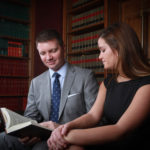Raymore personal injury lawyers and Belton, Harrisonville and Cass County personal injury attorneys will benefit from this continuing education post. This is an exemplar status letter from a Raymore personal injury lawyer to his insurance defense client, who is attempting to avoid a personal injury slip and fall claim in the Circuit Court of Cass County at Harrisonville.
This post will assist Raymore personal injury attorneys and Cass County accident injury lawyers in understanding the analysis personal injury defense law firms use in evaluating the testimony of the victims and any witnesses.
The names and some identifying information has been changed to protect the privacy of those involved.
Contact Pleasant Hill personal injury lawyer Matt Hamilton at 816-540-4040 if you have been involved in a personal injury accident. Each case presents its own unique facts and evidence. You will want an experienced personal injury lawyer from Cass County to analyze your case to get the best advise on how to proceed with a personal injury claim.
June 26, 2010
Carol Pleasant
Raymore Restaurant’s Inc.
1478 Elm Hill Pike, Suite B6
Raymore, MO 64083
Re: Case Style: Harrison, Sandi v. Raymore Restaurant’s, Inc.
Case No.: 11 CV 278932, Circuit Court of Cass County
Date of Loss: 10/09/2008
RSKCo No.: 10478968
Claim No.: 074564-25979
Dear Ms. Pleasant:
Your Raymore personal injury lawyers took the depositions of the accident plaintiff, Sandie Harrison and Floyd Cass, former manager of Raymore Restaurants, Inc. who witnessed events just after the plaintiff’s alleged slip and fall were taken recently. We have set forth a summary and our analysis of their depositions below for your review.
SANDI HARRISON
RAYMORE PERSONAL INJURY SLIP AND FALL VICTIM
Raymore personal injury accident victim Ms. Harrison is a lady in her middle eighties. She is of medium height and weight. She is well-spoken and comes across as intelligent, energetic, honest and frank. However, she does get confused, has trouble remembering the facts in this case at times and seems frail. Overall, she will make an above-average witness in front of a Circuit Court of Cass County personal injury jury.
Ms. Harrison is originally from Raymore, Missouri. She has eleven children; eight girls and three boys. The oldest child is John Cass, who is sixty-six years old. Every Friday, and sometimes on Saturday, Ms. Harrison goes out to dinner with John. For a number of years, they were regular customers of Raymore Restaurant’s. However, since the restaurant closed in 2009, they now go to “Jim’s.”
Raymore personal injury victim Ms. Harrison is self-sufficient with some age-related limitations. She lives by herself in Raymore, Missouri. Her daughter and other relatives help her clean and move things from time to time. Her son, John, drives her where she needs to go. Ms. Harrison also needs help opening the door of his van and occasionally needs assistance getting out. Otherwise, Ms. Harrison takes care of herself.
According to her testimony, Ms. Harrison is in excellent health for her age. Ms. Harrison wears bifocal glasses. She has good distance vision but needs the glasses to read. It appears that her vision is as good as any normal person. Ms. Harrison has a normal sense of balance and does not have a history of tripping over objects. She also does not have a significant medical history. These facts have been confirmed by our Lee’s Summit personal injury lawyers.
Ms. Harrison broke her left wrist approximately forty years ago in Harrisonville, Missouri. She also was examined at St. Mary’s hospital in November of 2009 for pain. She states that neither she nor the doctors discovered what was wrong with her. Her only current health complaints are her occasional back pain and more constant arm pain. These do not appear related to any Cass County injury accident.
The night of her personal injury slip and fall, Ms. Harrison and her son arrived at Raymore Restaurant’s at their usual time. The weather was clear and the lighting had not changed from her prior visits. Ms. Harrison remembers walking toward the Raymore Restaurant’s with her son, crossing a yellow striped handicapped area, tripping over something and falling down. (Exhibit “A”). When she looked up, she saw the car-stop just behind her.
Our Raymore personal injury lawyers revealed that Ms. Harrison was inconsistent in her testimony of whether she saw the car-stop before her fall. Several times she stated that she saw the car-stop both before and after her personal injury slip and fall. At other times, she stated that she does not remember seeing the car-stop before her fall. In any event, she cannot think of anything that prevented her from seeing it. She stated that no other witnesses saw her slip and fall. Her son was near her at the time. However, he was walking ahead of her with his back to her. Ms. Harrison stated she was helped back into the Raymore Restaurant’s by a man and a woman, where she waited for an ambulance to arrive to treat her personal injury.
The Raymore personal injury slip and fall broke Ms. Harrison’s right wrist. Also, her glasses fell off, were chipped, and needed to be repaired. Otherwise, she suffered no significant injuries. She now has a noticeable bump on her right wrist. Dr. Jelley, her physician, informed her that the bump would dissipate over time. Her last visit with Dr. Jelley was on December 11, 2008. The bump on her wrist has not dissipated to date. Presently, Ms. Harrison now has trouble lifting things and writing. Ms. Harrison also cannot fully extend her right fingers. Her arm still hurts and aches on a regular basis from the wrist down to her fingers due to this Raymore personal injury. Tylenol relieves the pain for awhile. She no longer needs and does not expect to need future medical treatment for her injury.
Ms. Harrison stated to out Raymore personal injury attorneys that the employees of Raymore Restaurant were always kind to her. She continued to frequent the restaurant even after her fall. She knows and remembers personal injury clam defendant Floyd Cass and continues to be fond of him.
FLOYD CASS
RAYMORE PERSONAL INJURY WITNESS
Floyd Cass is a sixty year old man of medium height and weight. He is well-spoken and comes across as both honest and forthright. He remembers this Raymore personal injury accident well and will make an above-average witness in front of a Circuit Court of Cass County jury. He was a manager at Raymore Restaurant for many years. Although he no longer works for the company, he continues to have good will toward Raymore Restaurant.
The Raymore personal injury lawyers took the deposition of this accident witness. Mr. Cass stated that the parking lot, including the area just outside of the restaurant where the plaintiff fell, was very well lit. The lights were on twenty-four hours a day and were bright enough to read in. The yellow striped handicapped area where the Raymore personal injury plaintiff claims to have fallen was not meant to be a walk-way for pedestrians despite the fact that patrons walked through it at times. (Exhibit “A”). Mr. Cass stated that it was placed there to give customers that were in wheelchairs room to exit their automobiles. The car-stops were placed at the end of the yellow striped wheelchair unloading area to prevent cars from bumping into each other in the parking lot. The handicapped customers who parked in the yellow striped area would have entered the restaurant using the handicapped ramp, which was located some ten to fifteen feet away.
On the day of the plaintiff’s Raymore personal injury slip and fall, Mr. Cass was acting as a manager at Raymore Restaurant’s. He remembers the weather as being both clear and dry. He was working on the waiting line when a customer came into the restaurant and said that a patron had just fallen outside. Mr. Cass immediately went outside to investigate. Once outside, he saw Ms. Harrison lying across a car-stop just outside of the restaurant. It was not the car-stop near the yellow striped handicapped area but rather a car-stop closer to the restaurant’s entrance. She was lying on her side in a north/south direction with her head to the north. Her legs were laying on the car-stop. She was holding her right arm and looked to be in pain.
Mr. Cass immediately went inside and told an employee to call 911, which was Raymore Restaurant’s standard practice in those situations. He then went outside to check on Ms. Harrison’s health. Before the ambulance arrived, Ms. Harrison walked back into the restaurant with the help of her son. It was thought that she would be more comfortable inside. The ambulance arrived, took Ms. Harrison and her son to the hospital and Mr. Cass returned to his duties.
Our Raymore personal injury attorneys discovered an interesting fact from this accident injury claim. Mr. Cass is sure that the plaintiff ate in the restaurant and then fell as she was leaving. This is because Mr. Cass saw the check she used to pay for her meal that day. In fact, Ms. Cass used the check to write down some of the plaintiff’s information on the Raymore Restaurant’s accident report.
In the weeks following this Raymore personal injury accident, Mr. Cass stated that Ms. Harrison continued to frequent the Raymore Restaurant’s restaurant as usual. Neither Ms. Harrison nor the Raymore Restaurant’s employees bore any ill will towards each other and remained on very friendly terms. The plaintiff’s Belton personal injury attorney failed to ask Mr. Cass whether he saw Ms. Harrison in pain or discomfort after her slip and fall accident injury. Mr. Cass has previously told us that the plaintiff was in great pain in the weeks after her slip and fall personal injury accident. Sometimes she could not eat and had to rest her head on a restaurant table during her meal because of the pain. Mr. Cass did not volunteer this information.
Our Raymore personal injury lawyers took the recorded statement of this witness prior to his deposition. In the recorded telephone conversation before his deposition, Mr. Cass also told this law office that the car-stop the plaintiff alleges to have fallen over was removed several weeks before the plaintiff’s fall. The car-stop had deteriorated and needed to be replaced. Mr. Cass believes that the car-stop was replaced the week of the plaintiff’s fall by Raymore Restaurant’s employees. The day Ms. Harrison fell would have been the first time she had returned to the restaurant since the car-stop had been re-installed. The plaintiff’s Belton personal injury attorney failed to ask Mr. Cass about this during his deposition. Mr. Cass did not volunteer the information.
Mr. Cass testified that no one to his knowledge has ever reported tripping or falling over a car-stop at the Raymore Restaurant. He remembers that a customer once slipped and fell in the parking lot during a rain storm. However, he recalls no other personal injuries outside of the building.
ANALYSIS AND FURTHER HANDLING OF THIS
RAYMORE PERSONAL INJURY ACCIDENT CLAIM
The legal issues in this case will likely turn on whether the placement of the car-stop presented an unreasonable risk of harm to Ms. Harrison. In Missouri, the elements of a submissible slip and fall case are (1) the existence of a property defect and (2) at least constructive knowledge on the defendant’s part. Cox v. J.C. Penney Co., Inc., 741 S.W.2d 28, 29 (Mo. banc 1987). First, a “defect” is a condition which creates an unreasonable risk of harm to a third party. Wyatt v. Southwestern Bell Tel. Co., 573 S.W.2d 386 (Mo.App. 1978). Owners, like Raymore Restaurant, have an obligation to exercise ordinary care to keep their premises in a reasonably safe condition. Id. However, they are not an insurer and do not owe persons on their premises absolute safety. Larrea v. Ozark Water Ski Thrill Show, Inc., 562 S.W.2d 790 (Mo.App. 1978). Second, “knowledge” on the part of a defendant is established when the defendant knows or by the exercise of ordinary care can discover the existence of the “defect,” and thereafter, has sufficient time to either correct or warn of the condition. McElroy v. S.S. Kresge Co., 244 S.W.2d 425 (Mo.App. 1951). Generally, “knowledge” is easily established where the condition is structural, such as a car-stop, which has existed for an extended period of time. Id. Thus, the Raymore personal injury plaintiff will need to show that there was a premises defect at Raymore Restaurant’s that created an unreasonable risk of harm to Ms. Harrison, thereby causing her accident personal injury.
Missouri law states that the presence of a car-stop, alone, is not a premises defect. Hopkins v. Sefron Fibre Can Company, 390 S.W.2d 907, 912 (Mo.App. 1965). However, the placement of the car-stop can be. Alexander v. National Supermarkets, Inc., 616 S.W.2d 873, 875 (Mo.App. 1981). Whether the placement of the car-stop amounts to a defect depends upon the circumstances of the case. Id. These circumstances can include but are not limited to whether the car-stop was separate and isolated from the other car-stops, whether it was located near an entrance to the building, why the car-stop was placed where it was, where it was placed in relation to the parked cars, and whether it was concealed from view. Id. In any event, if the alleged defect (the car-stop) is so open and obvious that the invitee should reasonably be expected to discover it and realize the danger, it is in “plain view” and is not a premises defect unless the land owner should anticipate harm despite the alleged defect’s obviousness. Harris v. Niehaus, 857 S.W.2d 222 (Mo. banc 1993); Seymour v. Lakewood Hills Ass’n, 927 S.W.2d 405, 410 (Mo.App. 1996).
Our Cass County personal injury lawyers revealed in the depositions of Ms. Harrison and Mr. Cass strong evidence that the car-stop should not be considered a premises defect. In her deposition, Ms. Harrison indicated several times that she saw the car-stop before she tripped over it. The car-stop was not an isolated object in the parking lot. It was placed along side other car-stops. (Exhibit “A”). Also, it was placed at the top of the yellow striped handicapped area as part of a row of car-stops. Arguably, pedestrians would expect a car-stop to be there. In addition, it was not concealed from view by another object. There was no reason for Raymore Restaurant’s to anticipate that a customer would fall over the car-stop because no other falls had occurred. These factors indicate that the car-stop was in “plain view” and not a premises defect.
In any event, Ms. Harrison’s failure to pay attention where she was walking should reduce any verdict she could receive through the application of comparative fault. In Cox v. J.C. Penney Co., Inc., 741 S.W.2d 28 (Mo. banc 1987), the Missouri Supreme Court considered a case where a business invitee tripped over a luggage strap in a department store. Id. The Court stated that the personal injury plaintiff’s failure to pay attention where she was walking and failure to otherwise use ordinary care went to the issue of comparative fault and reduced the judgment she received. Id. Here, too, we intend to show that the Raymore personal injury plaintiff failed to pay attention and use ordinary care. Ms. Harrison stated that she knew there were car-stops in the parking lot. She had been to the restaurant many times and was familiar with the layout of Raymore Restaurant’s well-lit parking lot. She seems to have normal vision and was not carrying anything that would have obstructed her view. There has been no indication that the car-stop was covered or hidden. Thus, our Cass County personal injury lawyers will argue her comparative negligence in failing to use ordinary care should reduce any judgment she may receive.
The deposition of Floyd Cass casts further doubt upon the liability of Raymore Restaurant. Mr. Cass came across as having a better memory of the events of that day than Ms. Harrison. He stated that Ms. Harrison did not fall near the yellow striped handicapped area as she claims. (Exhibit “A”). Rather, he states she fell close to the restaurant’s entrance. If the Cass County personal injury jury believes his testimony, the plaintiff’s Raymore personal injury lawyers’ theory that the placement of the car-stop at the top of the yellow striped handicapped area was a premises defect would not apply. If the Cass County jury believes Ms. Harrison’s testimony that she fell in the yellow striped handicapped area, the Raymore personal injury plaintiff will still need to show that the car-stop was a dangerous condition on the property.
Our Lee’s Summit personal injury attorneys intend to take the deposition of John Floyd, the plaintiff’s son, in the near future to get his version of where the personal injury accident occurred. His testimony will also provide evidence of how Ms. Harrison’s personal injury has affected her. A summary and an analysis of his testimony will be provided to your offices shortly thereafter. We also intend to get the medical records from the plaintiff’s eye doctors. These records should tell us whether the plaintiff had any eye conditions that would have hampered her ability to see the car-stop at Raymore Restaurant.
As always, our Raymore accident injury law firm will keep you apprised of any significant developments as they occur. If you have any questions or if I can help in any manner, please feel free to contact me.
Very truly yours,
Matthew J. Hamilton
Raymore Personal Injury Lawyer
MJH/ # 7094564


 Second, the lawyer needs to gain an expert opinion from a treating physician (or recognized medical expert) as to the reduction of pregnancy possibility. The relatively unknown, but instructive case of McKersie v. Barnes Hospital, 912 S.W. 2d 562 (Mo. App. 1995) is educational on this topic. In McKersie, the Missouri Court of Appeals considered a victim who had an accident. The accident reduced the victim’s ability to get pregnant. Ms. McKersie was treated in an emergency room by an intern. That intern was negligent and failed to diagnosis her appendicitis. As a result, Ms. McKersie’s appendix ruptured. This required her right ovary and her Fallopian tube to be removed. Her appendix was also removed.
Second, the lawyer needs to gain an expert opinion from a treating physician (or recognized medical expert) as to the reduction of pregnancy possibility. The relatively unknown, but instructive case of McKersie v. Barnes Hospital, 912 S.W. 2d 562 (Mo. App. 1995) is educational on this topic. In McKersie, the Missouri Court of Appeals considered a victim who had an accident. The accident reduced the victim’s ability to get pregnant. Ms. McKersie was treated in an emergency room by an intern. That intern was negligent and failed to diagnosis her appendicitis. As a result, Ms. McKersie’s appendix ruptured. This required her right ovary and her Fallopian tube to be removed. Her appendix was also removed. Author: Matt Hamilton
Author: Matt Hamilton 

 It is Saturday night. Robert owns a local coffee shop. This coffee shop is a building and a parking lot next to a crowded street. Young people like to congregate and socialize in its parking lot Saturday nights.
It is Saturday night. Robert owns a local coffee shop. This coffee shop is a building and a parking lot next to a crowded street. Young people like to congregate and socialize in its parking lot Saturday nights. A business owner can be liable to a victim on his property even when the perpetrator had nothing to do with the business owner.
A business owner can be liable to a victim on his property even when the perpetrator had nothing to do with the business owner.
 Author:
Author: How to Overcome Uncertain Treating Physician Testimony in Prosthetic Amputation Lawsuits
How to Overcome Uncertain Treating Physician Testimony in Prosthetic Amputation Lawsuits With physicians, this is the “reasonable medical certainty” standard. For example, in Missouri, the Supreme Court ordered in cases like
With physicians, this is the “reasonable medical certainty” standard. For example, in Missouri, the Supreme Court ordered in cases like  A second problem is the uncertainty of future medical treatment or repercussions. Doctors helping amputation victims cannot see the future. Future treatment or negative outcomes may be dependent upon events that do not occur. This second problem is physicians saying this may not occur unless one or two or three other events happen. Therefore, they give the opinion they cannot say to a reasonable degree of certainty because they do not know the certainty of these future events. This challenge can also be overcome.
A second problem is the uncertainty of future medical treatment or repercussions. Doctors helping amputation victims cannot see the future. Future treatment or negative outcomes may be dependent upon events that do not occur. This second problem is physicians saying this may not occur unless one or two or three other events happen. Therefore, they give the opinion they cannot say to a reasonable degree of certainty because they do not know the certainty of these future events. This challenge can also be overcome. The Missouri Supreme Court in the case of
The Missouri Supreme Court in the case of  Author:
Author: Matt Hamilton
Matt Hamilton

 Sometimes you do not have to directly pay the lawyer at all. Certain types of cases (like vexatious refusal to pay by insurance) carry with them awards of attorney fees. This means at the end of the case, if you win, the other side pays for your attorney’s fees.
Sometimes you do not have to directly pay the lawyer at all. Certain types of cases (like vexatious refusal to pay by insurance) carry with them awards of attorney fees. This means at the end of the case, if you win, the other side pays for your attorney’s fees. Like stairs, contingency fee amounts typically go up in steps.
Like stairs, contingency fee amounts typically go up in steps.